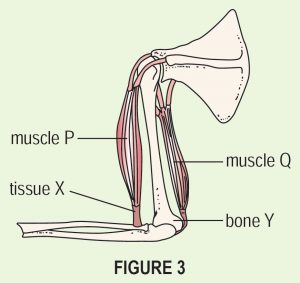Explain why muscle contractions require adequate blood supply.
Answer:
• Muscle contraction needs a lot of ATP energy produced during cellular respiration.
• A large amount of blood is needed to transport and supply oxygen and glucose to the muscle cells.
• At the same time, blood transports waste products such as carbon dioxide and lactic acid out of the muscle cells.

Figure 2 shows two types of vertebrae, X and Y in the human vertebral column.
(a) Name vertebrae X and Y.
(b) Explain the role of vertebrae during body movement.
(c) Relate the thoracic vertebrae to the breathing mechanism.
Answer:
(a)
X: Lumbar vertebra
Y: Cervical vertebra
(b)
The vertebrae provide a surface for muscle attachment. The vertebral column consists of many vertebrae which are connected to each other and enables the backbone to bend.
(c)
• The thoracic vertebrae possess a long spinous process and transverse process for muscle and ligament attachment.
• The thoracic vertebrae have a two-face joint on the transverse process forming a joint with the ribs. This allows the ribs to move up and down. The joints between the thoracic vertebrae and ribs enable the ribs to move up and down when the intercostal muscles contract and relax.

Figure 3 shows muscles P and Q, bone Y and tissue X that are involved in the forearm movement.
(a) Name muscle P and Q, bone Y and tissue X.
(b) State two characteristics of tissue X that enable it to function.
(c) If tissue X is torn due to an accident, what problems will the victim face?
(d) Suggest a suitable food for a person with fractured bone Y. In your opinion, explain why this particular food is presumed suitable for the individual.
(e) Explain how all the parts labelled in Figure 3 react in the condition shown.
Answer:
(a)
Muscle P: biceps
Muscle Q: triceps
Tissue X: tendon
Bone Y: humerus
(b)
Inelastic and can be bent
(c)
Movement cannot take place at the joints. Biceps is not attached to radius.
(d)
Milk, because it contains calcium for bone formation and growth.
(e)
When biceps contracts, the pulling force is transferred to the bone through the tendon.
This action causes the radius to be pulled up and the arm bends. At the same time, triceps relaxes.